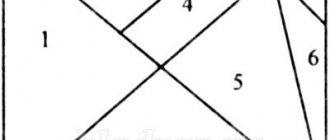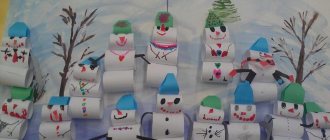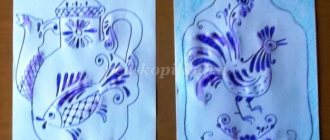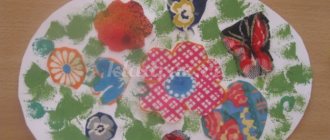Summary of educational activities for speech development in the middle group “Working in the garden”
Tatyana Ratieva
Summary of educational activities for speech development in the middle group “Working in the garden”
Summary of educational activities for speech development in the middle group » We work in the garden and vegetable garden. "
- continue to teach children to compose a story based on a plot picture, develop monologue speech, be able to listen, analyze, negotiate among themselves (who starts the story, who continues, who finishes)
- activate singular and plural present and past tense verbs in children’s speech; learn to correctly use plural genitive nouns; learn to form adjectives from nouns; learn to rhythmically combine movements and speech.
Looking at the paintings “In the garden”; " In the garden"
— What do these paintings have in common? How are they different? Who works in the garden and garden? What time of year do you think it is? Why did you decide so? What are the characters doing in these pictures? How can you say it differently? What are the children doing? (dig, loosen, carry, water, plant, collect (old leaves)
, dig up (weeds.)
- And if you imagine that children have been doing all this for a long time? How do you answer the question: “What did the children do?”
(They dug, loosened, mowed, watered, planted, collected, dug up.)
- Now imagine that you are working in the garden. Ksenya. What are you doing? (I dig, I plant.)
Petya, what are you doing? (I collect and water.)
Forms of labor organization in nature in the preparatory group
Page 1
What are the forms of organizing the work of preschoolers accepted in kindergartens - assignments, duty, collective work? What opportunities for raising children are hidden in each of them? Let's consider these forms of work
1) Instructions. Labor assignments are the simplest form of organizing children's work. They have a special educational significance when working with children of primary preschool age. A work assignment is understood as the assignment of a specific task to a child, which he must complete alone or with one of his peers. To assign means to oblige the child to do some kind of work related to both self-service and work for the team.
In the practice of educational work with children, individual assignments are especially common. From here, opportunities are created for the teacher to develop labor skills. The assignments are varied in difficulty (simple, complex), nature of execution (short-term, episodic, long-term). Special opportunities for developing skills are provided by long-term assignments, when the child is responsible for some task for a certain period of time.
Assignments are especially important between 3 and 5 years. At the age of 6, children can participate in three types of duty. This is serious work that also requires preliminary preparation.
In preschool groups, children’s physical capabilities expand and they gain experience in independently completing assignments. Many assignments included in their responsibilities are of a permanent, systematic nature. At the same time, the instructions do not lose their significance.
2) Duty. Duty duties are a more complex form of organizing children’s work compared to assignments. They require more independence from the child. Duty duties are of great importance in raising children: those on duty always perform work that has social significance and is necessary for the team. This helps, in accessible specific matters, to form in children a desire to work for the sake of others, to show an attitude towards their comrades, towards animals and plants located in a corner of nature, and also to develop their ability to help an adult, to notice where help is needed.
The duties of older preschoolers are gradually becoming more complicated both in the content of work and in the forms of unification of children, in terms of the requirement for independence and self-organization in work. Children are regularly on duty in preparation for classes, in a corner of nature. Usually two children are assigned to each type of duty.
Nature corner duty is introduced in the senior group. The meaning of this type of duty can be explained in class. The teacher draws attention to the new inhabitants of the living area and tells how to care for them.
He especially emphasizes the importance of careful ongoing care of animals and plants: only under this condition will they be happy in the group. During the lesson, the teacher can also show some of the techniques of those on duty: how to spray plants with a spray bottle, how to prepare water for watering plants, etc.
It should be noted that the work of those on duty will be more successful if the teacher constantly instills in everyone an interest in the corner of nature.
In preparation for the school group, the amount of work of those on duty can be increased: children make sure that the animals always have green food (they occasionally sow oats); They grow greens for the table, with the help of the teacher, they transplant flowering plants from the lawns and transfer them to the group.
3) Teamwork. In the senior and school-preparatory groups of the kindergarten, common work activities are systematically organized, uniting all the children of the group at once.
So that all children can take part in collective work at the same time and the teacher can supervise their work, it is necessary to take into account a number of conditions:
— all children can be united only after they have acquired the necessary experience of working in a small team
- when determining the content of general work, the teacher includes in it only those types of work, the skills of which the children master well enough and strive to keep all children occupied.
“The joint work of children should be especially appreciated - these are the beginnings of collective work,” says Nadezhda Konstantinovna Krupskaya. “The child’s strengths are best developed in collective work.”
Pages: 1
Other things about pedagogy:
Employment of students during their studies It is quite obvious that students who go to study abroad, as a rule, can study and live without part-time work. Many students are financed by parents or relatives who carefully think through and calculate all upcoming expenses. However, students who decide to work part-time in their free time from studying...
Methodology for organizing and conducting excursions A nature excursion includes an introductory conversation, collective observation, individual independent children's observations and collection of natural material, children's games with the collected material, the final part, where the teacher, summing up, draws the children's attention to the overall picture of nature. Post...
The state of the problem of developing the ability to tell stories in children of the seventh year of life. To study the peculiarities of developing the ability to tell stories in children of the seventh year of life, we conducted a study on the basis of MDOU d/s No. 4 in the village of Troitskoye. The study involved 20 children of senior preschool age (6-7 years old): 9 boys and 11 girls. The purpose of the ascertaining stage of the study was to...
Summary of work activity in a corner of nature for the senior group.
Summary of work activity in a corner of nature for the senior group.
In our kindergarten, the education and upbringing of children takes place in accordance with the Federal State Educational Standard, the program of which includes the development of labor activity, where the following tasks are set:
1. Raising in children a respectful attitude towards work.
2.Teaching children labor skills, skills of organizing and planning their work.
3. Education of moral and volitional qualities, habits of work effort.
4. Fostering a humane attitude towards others: the ability and desire to engage in joint work with peers.
Types of work provided:
- Self-service.
- Labor in nature.
- Manual labor.
— Familiarization with the work of adults.
In most detail, I want to dwell on work in nature in the older group.
Abstract
(care for indoor plants)
Form of organization: collective work.
Type of labor: labor in nature.
Program content: Bring children to the concept of collective work, to the conclusion about its value, to the realization that work can bring joy and a sense of satisfaction. Teach children to treat plants as living beings, continue to teach practical help and empathy. The ability to properly hold a watering can with water, the skill of carefully wiping strong, leathery leaves, holding the leaf from below with a cloth. Learn to care for indoor plants and maintain curiosity. Strengthen your knowledge of the names of indoor plants.
Methods and techniques: surprise moment, play techniques, questions to children, showing ways of care, involving children in action, instructions, reminders, assessment of children's activities.
Materials and equipment: oilcloths for tables, sticks for loosening, rags for wiping off dust, brushes for cleaning fuzzy leaves of indoor plants, spray bottle, watering cans, basins.
Indoor plants: violet, balsam, sansevieria.
Progress of work:
Hello guys.
- Guys, today a mole came to visit us. But the mole came for a reason, he came on business. The mole decided to warn you and me and save our plants in the group.
- Listen to what the mole says!
- "Guys! Trouble! The evil wizard found out that we have a lot of beautiful plants in our group and decided to take them away from us! He sent his assistants - dust and dirt, so that they settled on the plants, and they dried up."
- Don’t be sad, mole, we will save our plants!
— To make it beautiful in our group, we need flowers. Plants release oxygen and clean the air of dust. Some houseplants can heal.
- In order for them to continue to please us, for them to live well in our group, they need: water, light, warmth, earth, air, food. Show diagrams.
-The plants need to be watered and the soil loosened. It is necessary to spray and wipe large leaves so that the plant can breathe. Love flowers and care for them properly.
— And to find out whether these plants need care.
You can touch the soil with your finger; if the soil is wet, it will remain on your finger. This means that this plant should not be watered. If the soil is hard, then it needs to be loosened. And if there is no dust on the leaves, then there is no need to wipe with a cloth.
— For plants, guys, there are symbols for what they need (show symbols).
“Now I’ll tell you riddles, and you guess what kind of flowers they are.”
Flat, long, not a beam.
Striped, not watermelon (Sanseviera)
Show care plan.
- Look, this is how we will wipe large leaves with a wet cloth. We take a cloth, wet it in a basin of water, then wring it out thoroughly and spread it on the palm of our hand. We support the sheet from below with one hand, and with the other we wipe the sheet from above, then from below. Like this.
Purple flower.
There is a yellow eye in the center,
The leaves seem to be covered in fluff,
I’ll pick it now and give it to my girlfriend! (Violet).
Show care plan.
— Carefully brush off the dust from the violet’s fuzzy leaves with a dry brush.
On the window in winter and summer
Forever green and beautiful.
Bright red color
Burns gently... (Balsam).
Show care plan.
- Plants with small leaves, such as balsam - we will spray.
- Let's start working to save our plants. Choose icons that are appropriate for your plants so we don't forget what they need to be healthy. They come out to see who received the badges.
- And you guys, guess the riddles. Making riddles about flowers.
- Now let's play a little.
Take a quick look at the window: (both palms show)
Here we have geraniums blooming. (bend fingers into a fist, starting with the little finger)
And here is a handsome balsam,
Amarylliss is next to him.
Fuchsia, begonia-
We remember all the names (open palm)
We will loosen the flowers and water them (they move their fingers down)
Let them grow up day by day! (both palms are connected with a “bud”, raised above the head and opened with a “flower”).







